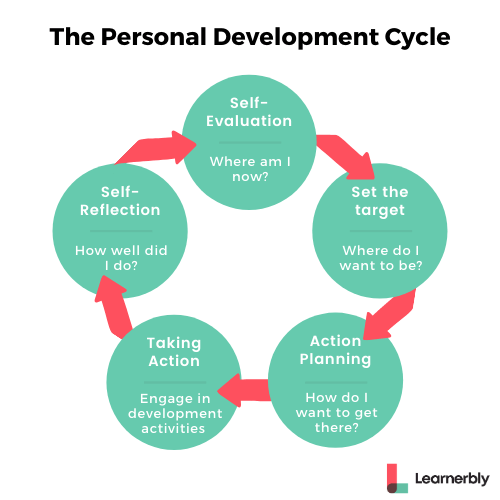By Melissa Malec
A goal without a plan is just a wish. – Antoine de Saint-Exupéry
By failing to prepare, you are preparing to fail. – Benjamin Franklin
Plan your work and work your plan. – Napoleon Hill
There are countless quotes about planning. A simple Google search will reveal that. As you scroll through the words of great achievers from history, it becomes clear that as people, we place a lot of value in planning and that when done correctly, plans work.
The potential to be great lies within all of us. With the right tools, guidance and support, we all stand a chance to fulfil that potential, maybe even landing ourselves in the history books along the way. By having a personal development plan at work, your people are equipped to do just that.
Training and progression have become one of HR’s top five priorities for the first time, with more HR leaders willing to train and upskill under-qualified candidates than in years prior. It’s great that HR professionals are acknowledging that growth, but their people won’t progress unless they can introduce a structure to help them do so.
Of course, an idea is nothing without a plan. Here’s a guide to help you support your people when implementing their personal development plans at work.
🛑 Real quick! What is a personal development plan?
Personalised personal development planning should:
– reflect your aims and goals for the short, medium or long-term
– take into account your individual reality
– revolve around the skills and knowledge you currently lack
– outline development activities to meet perceived needs
The keyword in ‘personal development plan’ (PDP) is personal.
PDPs need to be specific to the individual it is made for. You can’t take on someone else’s PDP and expect the same results.
The motivations that went into the plan, the learning preferences and the existing skills and experiences are all different. Success lies in how catered it is to you.
A personal development plan sets the course for your growth and allows you to know the whys and hows of your journey.
The first step of any PDP is to establish where you are so that you can get where you’re going. Think of it as your cars GPS which can only guide you to the best route if it knows where you are. The reflective nature of these plans will lead you and your people to success.

Why should personal development exist in the workplace?
In a lifetime, the average adult spends 90,000 hours at work. 🤯
That means two things. One, personal time is sacred. Two, who we work to become benefits ourselves and the business we work for.
My growth in and outside of work hours will make me a better person, employee and writer. All three of those contribute to how I perform in my role and how I impact the company that I work for.
You’ll find it’s the same for those at your company. What they want to achieve will make them better at their job too.
Companies also have a responsibility to help their employees grow. In a healthy relationship, both parties give and take. An employee and the company they work for are in a relationship.
Employees give their skills and abilities to the company and that company benefits as a result.
Good companies make sure that the relationship is healthy by providing the opportunity and support for their people to grow.
Why not professional development?
All of this talk about personal growth at work may have you wondering why I’m not talking more specifically about career progression.
Could employees not equally benefit from a professional development plan as much as they would a personal development plan? And wouldn’t it be more appropriate for employee growth?
Applying the word professional gives too much context to what the employee will ultimately choose to develop. You don’t want to silo them toward career planning when that isn’t what they want to do.
Many employees will want to develop skills more in line with professional aspirations, but through using the term ‘personal’, you are being inclusive of the employees who, for example, want to work on being more mindful.
A checklist to get your workforce to engage in personal development
To make sure that employees pursue their goals, people functions can introduce the personal development plan and support the process of achieving the goals set out in them.
[ ✔️ ] Establish Psychological safety
People often feel that they should already possess all of the skills they need to do their job.
That’s unrealistic. People must feel that they can acknowledge where they have blind spots and where they have weaknesses.
They also need to feel safe in taking the time to find out what it is they want to achieve if they don’t already know.
They can only do this if their workplace has established psychological safety. Without it, employees may feel threatened by their need to cultivate the skills they lack and any plan they do make becomes a performative exercise. The goal isn’t to have the PDP in place; it’s to have them act upon it.
[ ✔️ ] Provide the tools and frameworks to build PDPs
You want people’s PDPs to be built to deliver successful results. To achieve this, your people need to know how to set SMART goals and more specifically, how to identify their North Star goal.
Introducing training sessions where the whole team attends is as essential as having the PDP in the first place.
Make the information digestible and actionable by having multiple sessions that focus on different parts of the goal-setting process.
For example, at Learnerbly, we have a session on goal setting, followed by presenting a few different PDPs so that people can think about what structure suits them best.
PDPs are cyclical. The journey of learning never ends, and the progress never stops because when you get where you’re going, you find you now have somewhere new to go.
Facilitate regular re-visits to the frameworks and tools you implement so that your people know and trust that you’re always there to take them further.
[ ✔️ ] Make the time for them
Finding time for learning is notoriously difficult. Employees either feel guilt over taking time away from their tasks to engage with learning, or they feel that the learning they are being offered isn’t worth their time.
The solution for the first instance is to schedule learning into workdays the same way that you would schedule a meeting. The solution for the second is Learnerbly 😉.
You can’t wait for employees to find the time, you must make it for them. With enough repetition, it becomes akin to muscle memory, where learning will happen without much effort.
It can be helpful to institute ‘learning hours’ where employees take an hour every week to learn whatever they want.
That might look like scheduling an hour to learn a language, read a book or nurture skills to achieve career progression. Every week could focus on different learnings.
These opportunities are important for making learning at work second nature. When something is woven in intentionally enough times, it can quickly become something we do unconsciously.
[ ✔️ ] Encourage them to share their goals
As our People Operations Manager Marie says, ‘sharing is caring.’ It’s important to know that this step can only come once psychological safety has been established.
Sharing goals and career plans can be a source of accountability, inspiration and support.
When colleagues and managers know what you’re working towards, they can recommend resources and opportunities to you to help you on your journey.
Make sure your employees have a way to communicate their goals and their progress.
This can be a Slack channel dedicated to celebrating what they achieve, a portion of your whole team meeting dedicated to sharing learnings or a place for small and random groups to meet virtually or in-person with the sole purpose of sharing.
All of these options create opportunities for sharing but also to help each other with recommendations, tips and even insights into how they plan and process their own PDP.
[ ✔️ ] Have managers share their PDPs & goals
Managers have goals, too. They have skills they could improve. They have shortcomings that if worked on, could make them better leaders.
Learnerbly CEO, Rajeeb Dey MBE stresses the importance of leading by example, “At Learnerbly, I take the opportunity to share my 360 feedback with the whole company at least once a year and focus on the things I feel I need to work on. If you want to encourage others to take ownership of their development, then it starts with you.’
When a manager shares their PDP and goals, they are showing that career progression is possible even before you tick every box for the role. It’s inspirational to know that, to see how those above you on the career ladder are working to better themselves and that they’re open and receptive to upwards feedback.
What can managers do to support an employee’s personal development plan?
Beyond sharing their PDP as inspiration and relatability, a manager has a place in driving the PDPs of their people. You may have read my piece on self-managed learning, where I talked about how a manager can support employees on their path to lifelong learning. Consider this section a follow-up, because a self-managed learner with a personal development plan is built to achieve both short and long-term goals.
Managers contribute to an employee’s Personal Development Plan in these three ways:
- Finding the targets. Often, employees aren’t quite sure what their long-term goals are, and if they have them, it’s difficult to envisage a path to getting there. Part of being a manager is spotting talents and abilities in your team members that they may not know themselves, and highlighting ways they can either improve on them or spot how they can be put into action to move them from potential to practical use.
- Holding them accountable. Having a written PDP means you’ve set specific targets that you’re holding yourself to, but if only you are looking at them, it’s easy for deadlines to slip as other things come up. Managers can play a role in regular check-ins, encouraging their team members towards ensuring targets are met. The employee is the one who owns and sets the destination; a manager is there to question, challenge, direct and nurture them on the journey of life-long learning.
- Sourcing help. A significant part of Learnerbly’s Personal Development Plan tool is being able to link resources to specific goals. For managers, they can help direct employees to things they’ve found useful themselves or things which will help with the roadmap ahead.
To come: the ultimate personal development plan template
A personal development plan template is what your employees need to make their development personal. We’re working on our own template to help you and your people find and achieve the goals they want, the way they want to. Come back to this blog, subscribe to our newsletter or follow us on our socials, so you don’t miss it when it’s live.
About Author:

Melissa Malec is the Content Editor at Learnerbly – a workplace learning platform that enables businesses to build learning cultures that empower employees to own their development.












